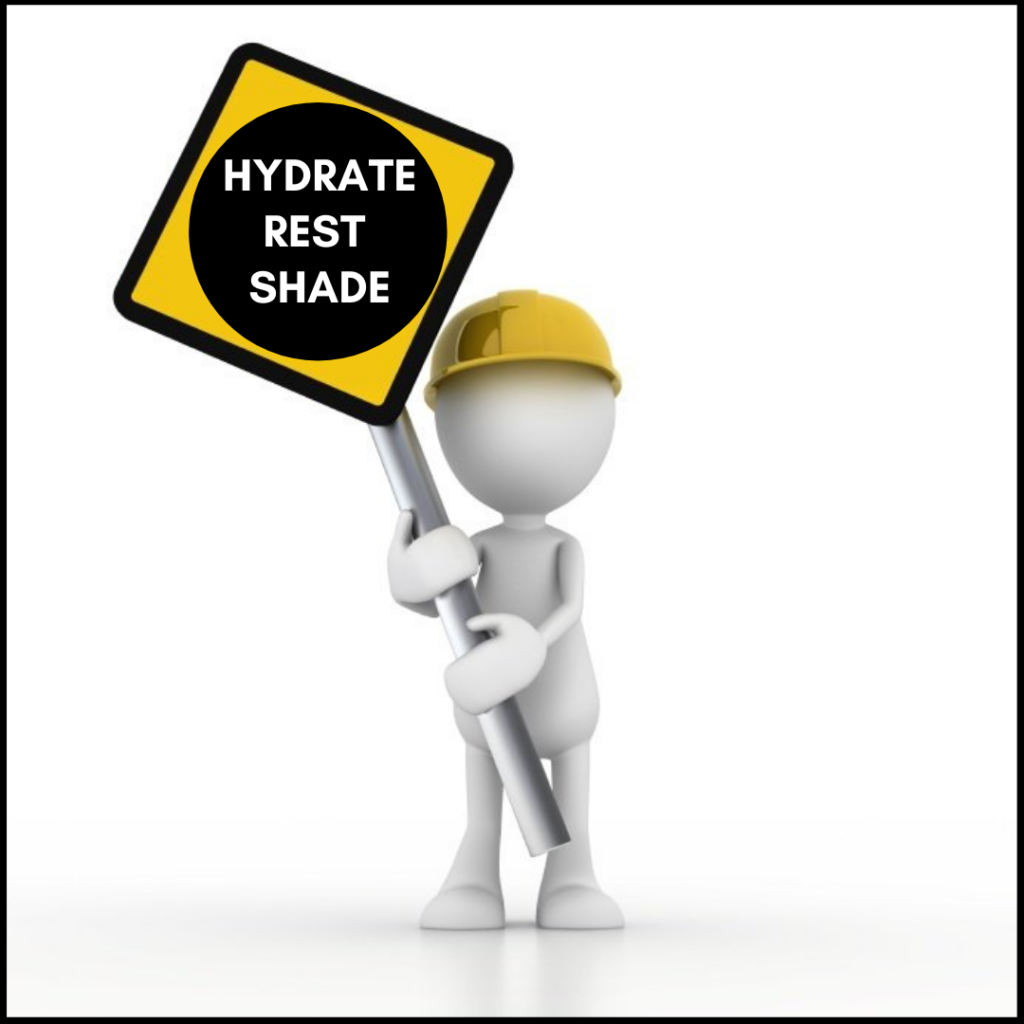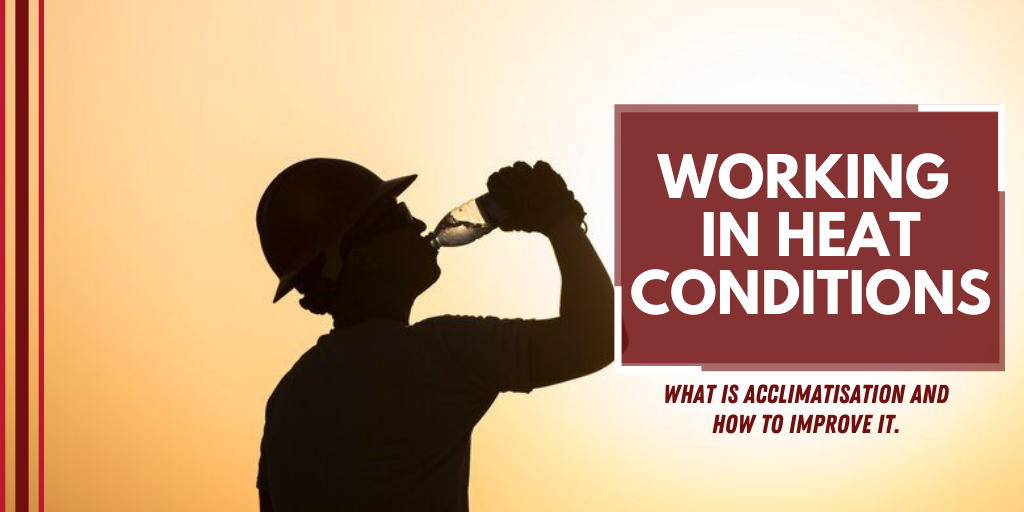In Australia, it is common for the resources sector to have “fly-in fly-out” (FIFO) employees flown from their home cities or towns in the populated and generally cooler regions to the northern or inland regions of the country where temperatures can be extremely hot and humid and consistently record over 40 degree days (Bureau of Meteorology, 2021).
The employees are flown to their workplace for extended periods ranging from 1 or more weeks to work 12-hour days (Bandy, 2008). While onsite employees are exposed to extreme heat conditions and return home to cooler conditions for their rostered time off (R & R). The transition between the body adapting to the significant climatic changes is known as Acclimatisation. Acclimatisation can affect all FIFO workers, not just those employees working a physical job outside but even those working inside in an airconditioned office (Zander, et al., 2018).

It is important to manage employee acclimatisation carefully. Failure to manage this situation can result in excessive heat stress, leading to heat illness, poor safety, low productivity, poor morale, and increased costs (Brake, 2002).
What is Acclimatisation?
Acclimatisation is defined as “the progressive adaptation of an organism to any change in its natural environment that subjects it to physiological stress.” (Oxford Reference, 2021). In the case of FIFO workers, Acclimatisation assists the body’s ability to regulate temperatures when subjected to heat stress (Bandy, 2008) and adapt to the cooler climate when returning home on R&R.
Acclimatisation usually occurs over about two weeks in healthy, normal persons. This process is faster in response to heat but slower in the cold (University of IOWA Hospitals and Clinics, 2021). A study found that a 70 per cent gain of achieving full Acclimatisation in a hot climate occurs in the first seven days of continuous exposure and the most significant improvements occur in the first three days of exposure (Brake, 2002). It takes 7 to 21 days to lose gains made in Acclimatisation (Brake, 1998).
Many factors influence a person’s rate of Acclimatisation (University of IOWA Hospitals and Clinics, 2021):
- Body fat – leaner people tolerate heat better than people that carry more fat and those that carry more body fat cope better in colder climates than thinner people would.
- Age – Older adults do not tolerate temperature extremes as well as younger persons. As a person ages, their response to shivering in low temperatures and sweating in higher temperatures is delayed and reduced.
- Medications – Some medications can interfere with parts of the brain responsible for temperature regulation, for example, asthma and hayfever medications.
- Metabolic rate – Someone with a high metabolic rate produces more heat than someone with a low metabolic rate and therefore will feel warmer and a person with a low metabolic rate will feel colder.

Physiological changes that occur in the body during Acclimatisation
Many physiological changes occur in the body during the Acclimatisation process. Some changes observed in a study undertaken in 1998 (Brake, 1998) on heat acclimatisation observed the following changes:
- Reduction in heat rate of 153 to 127 beats per minute;
- Core temperature reduced;
- Sweat becomes dilute with sodium concentration down by 29%;
- Rapid onset of sweating by up to 15%;
- Blood volume increased by 21%.

Other observed changes during Acclimatisation are an increase in total body water and increased resistance to sweat gland fatigue (Brake, 2002).
A study found that FIFO participants heart rates decreased daily by an average of 0.8 beats per minute, over a 13-day monitoring period whilst at work. This indicates the heat acclimatisation process can be disrupted by time off at home in a cooler climate (Bandy, 2008).
Health and safety impacts of Acclimatisation
FIFO employees who are office-based and rarely experience heat exposure by staying in air-conditioned environments are likely to achieve relatively low levels of Acclimatisation. Employees who have moderate heat exposure or work inside but undertake exercise outside in the heat are likely to achieve partial Acclimatisation. Employees who do most of their workday outside in the heat are expected to achieve high levels of Acclimatisa tion (Taylor & Cotter, 2006).
The failure for employees to acclimatise efficiently can result in severe health and safety consequences such as heat illness. Heat illness symptoms range from headaches and nausea through vomiting and fainting to more severe central nervous system disturbances. The most severe form of heat illness is heat stroke, which, if untreated or too severe, can result in death and frequently leads to permanent organ damage (Brake, 2002).

When exposed to heat, the thirst sensation of unacclimatised persons is also much weaker than that of acclimatised persons, which predisposes the unacclimatised persons to a much greater probability of dehydration – one of the most common causes of heat illness (Brake, 2002).
Immediate and long-term measures to avoid heat stress risks and improve Acclimatisation
Inability to gain full Acclimatisation in an occupational setting results in lower productivity, poor morale, an increased risk of fatigue and more serious forms of heat illness (Brake, 2002). Therefore, it is important that measures are implemented to mitigate these risks and optimise an employee’s acclimatisation efficiency when returning to the workplace.
Measures that can be implemented to avoid heat related illness and aid employee acclimatisation include:
- Schedule outdoor work for cooler parts of the day if possible (Work Safe Australia, 2021).
- Take regular breaks in a cooling environment (Work Safe Australia, 2021).
- Salt supplementation during heat exposures to avoid hyponatraemia risk (e.g. extra salt on meals or water intake) (Zander, et al., 2018).
- Regular hydration.

Sweat inducing heat exposure of between 30 and 120 minutes per day can aid in building up quicker Acclimatisation (Brake, 2002). This could be in the form of exercise outside or working outside to gain exposure.
A longer-term and more sustainable measure of achieving quicker Acclimatisation comprises two to six weeks of daily exercise for approximately 2 hours in the temperature being acclimatised to (Kosaka, et al., 2004). These sessions of intensified thermoregulation facilitate rapid attainment of heat acclimatisation, help to restore optimal core temperatures and avoid overheating. A study undertaken in recreationally active participants showed that 75% of physiological adaptations were evident within the first 4-6 days of heat stress exposure (Weller, et al., 2007).
If you or your organisation would like to learn more about managing occupational Acclimatisation, please get in touch with us at Integrate Sustainability by email at enquiries@integratesustainability.com.au or call us on 08 9468 0338.
References
Bandy, F. &. O. J., 2008. Heat acclimatisation: The impact of fly-in fly-out (FIFO) rosters on heat acclimatisation of Australian open cut mines. Journal of Health, Safety and Environment, 34(1), pp. 77 – 84.
Brake, R., 1998. A New Generation of Health and Safety Protocols for Working in Heat. s.l., Queensland Mining Industry Health and Safety Conference Proceedings – 1998.
Brake, R., 2002. A quantitative method of assessing the impact of Acclimatisation in the workplace. [Online]
Available at: https://www.qmihsconference.org.au/wp-content/uploads/qmihsc-2002-writtenpaper-brake.pdf
[Accessed 25 August 2021].
Bureau of Meteorology, 2021. Monthly mean maximum temperature – Telfer Aero. [Online]
Available at: http://www.bom.gov.au/jsp/ncc/cdio/weatherData/av?p_nccObsCode=36&p_display_type=dataFile&p_stn_num=013030
[Accessed 25 August 2021].
Bureau of Meteorology, 2021. 111 years of Australian temperatures. [Online]
Available at: http://www.bom.gov.au/climate/history/temperature/
[Accessed 25 August 2021].
Kosaka, M. et al., 2004. Human body temperature regulation in the extremely stressful environment: epidemiology and pathophysiology of heat stroke.. Journal of Thermal Biology, pp. 495-501.
Oxford Reference, 2021. Oxford Reference. [Online]
Available at: https://www.oxfordreference.com/view/10.1093/oi/authority.20110803095346259
[Accessed 25 August 2021].
Taylor, N. & Cotter, J., 2006. Heat adaptation: Guidelines for the optimisation of human performance. International Sports Medicine Journal, Volume 7, pp. 33-57.
University of IOWA Hospitals and Clinics, 2021. Acclimatization (adjusting to the temperature). [Online]
Available at: https://uihc.org/health-topics/acclimatization-adjusting-temperature
[Accessed 25 August 2021].
Weller, A., Linnane, D., A.G, J. & Daanen, H., 2007. Quantification of the decay and re-induction of heat acclimation in dry-heat following 12 and 26 days without exposure to heat stress.. European Journal of Applied Physiology, Volume 102, pp. 57-66.
Work Safe Australia, 2021. Working in Heat. [Online]
Available at: https://www.safeworkaustralia.gov.au/topic/working-outside#working-in-heat
[Accessed 25 August 2021].
Zander, K., Mathew, S. & Garnett, S., 2018. Exploring Heat Stress Relief Measures among the Australian Labour Force. International Journal of Environmental Research and Public Health, 15(3), p. 401.

